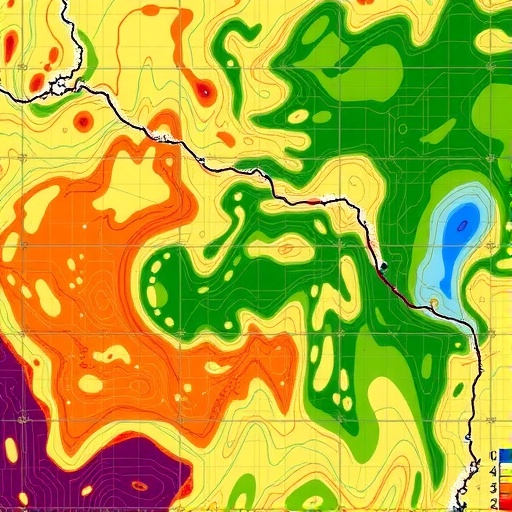A groundbreaking study from a team of researchers led by Mederer et al. has shed light on the intricate patterns of functional diversity in ecosystems, a critical factor in understanding biodiversity and ecological health. The study, titled “Unraveling the seasonality of functional diversity through remote sensing,” published in Commun Earth Environ, utilizes advanced remote sensing techniques to examine how functional diversity—the range of different roles or functions that species perform within an ecosystem—fluctuates with seasonal changes. This research is particularly vital in the context of global environmental change, as understanding these dynamics can inform conservation efforts and resource management.
Functional diversity is not merely a classification of species; it relates to the ecological roles these species play, such as pollinators, decomposers, and primary producers. It can greatly influence ecosystem resilience and the services that nature provides to humanity. Mederer and colleagues’ research highlights the necessity of integrating functional diversity assessments into traditional biodiversity studies. By using remote sensing, they have effectively bypassed many of the logistical challenges associated with field surveys, providing a broader spatial and temporal scale analysis of ecosystems.
The researchers employed satellite imagery and aerial data with high-resolution capabilities to assess functional diversity across various ecosystems. This method allows for the monitoring of changes in vegetation patterns, which can be indicative of shifts in ecosystem functionality due to seasonal variations. Remote sensing technologies enable researchers to capture and analyze the data required to investigate these ecological changes, offering a more comprehensive view of how ecosystems respond to seasonal transitions.
One of the remarkable findings in this study is the identification of seasonal peaks in functional diversity, often coinciding with critical environmental events such as flowering seasons or migration patterns. These peaks are essential indicators of ecosystem productivity and health, providing insights into how well an ecosystem can adapt to changes such as climate change or habitat loss. Mederer et al. emphasize the importance of recognizing these patterns to develop effective stewardship initiatives for ecosystems under threat.
Moreover, the study unraveled a complex interplay between climatic factors and functional diversity. Various climatic determinants—ranging from temperature to precipitation patterns—were found to influence the multitude of species that inhabit an area during different seasons. This interaction is crucial for predicting how ongoing climate change could alter future functional diversity, thus affecting the vital services ecosystems offer. Understanding these relationships is imperative for policymakers to implement adaptive measures safeguarding biodiversity.
The researchers also placed a strong emphasis on the implications of their findings for remote sensing applications within conservation biology. By advocating for the mainstreaming of functional diversity assessments through remote sensing, the authors argue for a paradigm shift in how conservation policies are formulated. This study serves as a clarion call to harness innovative technologies for better ecological management, aligning scientific understanding with real-world applications.
In light of ongoing global environmental crises, the urgency of Mederer et al.’s work cannot be overstated. Ecosystems around the world are under unprecedented stress, and understanding functional diversity through remote sensing might hold the key to developing resilient ecological networks. The insights gained from this research can guide conservationists and resource managers in making informed decisions about where to direct conservation efforts and how to prioritize ecosystems based on their functional diversity profiles.
Furthermore, the methodology employed in this study can be replicated across different geographical contexts and ecosystems, opening up new avenues for research into functional diversity on a global scale. The flexibility of remote sensing technology allows for the continual monitoring of ecosystems, which can provide real-time data on biodiversity changes, further enhancing our understanding of ecological dynamics.
In conclusion, the intricate relationship between functional diversity and seasonal change, as uncovered by Mederer et al., underscores the critical need for interdisciplinary approaches that merge technology with ecological research. The implications of this study stretch far beyond the academic realm, providing a blueprint for future studies and a framework upon which effective conservation strategies can be built. As we forge ahead into an era marked by rapid ecological shifts, the insights provided by this research will undoubtedly play a vital role in informing the policies and practices that protect our planet’s rich biodiversity.
The findings of this pivotal study can serve as a foundation for future research endeavors aimed at elucidating the complexities of functional diversity. The capacity to track changes over time through remote sensing not only enhances scientific knowledge but also empowers stakeholders at all levels to engage in informed decision-making and advocacy for sustainable ecosystems. Therefore, embracing the fusion of technology and ecology as demonstrated by Mederer and his team is essential to navigating the intricate challenges posed by environmental change and ensuring the survival of diverse ecosystems worldwide.
In summary, this groundbreaking study encapsulates the intersection of technology, ecology, and sustainability. By capturing the seasonal ebb and flow of functional diversity, Mederer et al. pave the way for a comprehensive understanding of how ecosystems operate and how we can effectively manage them amidst the challenges of climate change. Their work stands as a testament to the ongoing evolution of ecological research and the vital role of innovative methodologies in addressing the pressing issues of our time.
Subject of Research: Functional diversity and its seasonal dynamics through remote sensing.
Article Title: Unraveling the seasonality of functional diversity through remote sensing.
Article References:
Mederer, D., Kattenborn, T., Cherif, E. et al. Unraveling the seasonality of functional diversity through remote sensing. Commun Earth Environ 6, 790 (2025). https://doi.org/10.1038/s43247-025-02646-x
Image Credits: AI Generated
DOI: 10.1038/s43247-025-02646-x
Keywords: Functional diversity, remote sensing, ecosystem health, biodiversity, seasonal dynamics, climate change, conservation strategies.




